Prologue to finding the missing genealogy document to extend a Polson family line
This post is part 1 of a three part series telling the story of a genealogy quest to extend a family line beyond a dead end that lasted over 3 decades. It includes many names, dates, and places because those are central to much of what genealogy is all about, however the posts focuse on the quest. I hope they inspires others facing similar roadblocks and provides some ideas and insights that might help you along the path a little faster than I was able to trod.
The Beginning
I first turned to family history about 1980. Previously, my own family only knew our direct Polson genealogy to my father’s grandfather, William Alexander Polson who married a Cherokee woman in Indian Territory (now Oklahoma).
With some help from my family, and tremendous help from several others that had already researched the ancestors of my great-grandfather Polson, my direct family was quickly extended to included my great-great grandfather Jasper Alexander Polson, born in north west Arkansas, Washington County, in 1839. At the same time, I learned Jasper Alexander Polson’s father, William G. Polson, previously of Lincoln County Tennessee born about 1809. Earlier in his life, William G. Polson spelled his last name as Polston.
With minimal effort on my part, I had quickly extended my direct Polson line another two generations, but the trail abruptly ended there. As the years went by I was able to learn and then prove the “G” in William G. Polson stood for “Greer” and that he and/or his family had at one time or another said he was born in a host of different states. If I recall correctly, various documents have him born in KY,TN,AL, and GA. I posted my work online, History of the family of William G. Polson (no longer online), hoping to find others who could help me further extend the line, but nothing came of it.
I learned of a Mary Henrietta Polson similar in age to my William G. Polson, that married Josiah Norwood and lived among many of my Polson ancestors in Washington County, Arkansas. But I was never able to tie her directly to my family.
I learned the 1830 Lincoln County, Tennessee census showed William G. Polston with what appeared to be a “Jr.” after his name, while living next door to an older gentleman also named William Polston. This fit with the research of others, William G. Polson’s father was named William Polston. But I wanted more than just a name, who was he?
I learned three of William G. Polson’s sons fought for the Confederacy with the Cherokees under Stand Watie, a well known Cherokee and the last Confederate General to surrender. I always thought that was a bit odd, that all three brothers fought with the Cherokees when only one (William David Polson) was known to have been married to a Cherokee (Flora Ridge, daughter of the well known John Ridge, son of Major Ridge). William David (W.D.) Polson was a surgeon in the war and was involved in various businesses with Stand Watie after the war. As time went on, the name Flora was given to many descendants of William G. Polson and to descendants of allied families.
With no progress being made toward identifying the parents of William G. Polson, I took to creating a large genealogy chart of the 5 Founding Families of the Farmington Ebenezer Methodist Church in Farmington Arkansas in 1833 based on an article I found in the Tulsa Genealogical Society Library. One of those families was that of my William G. Polson.
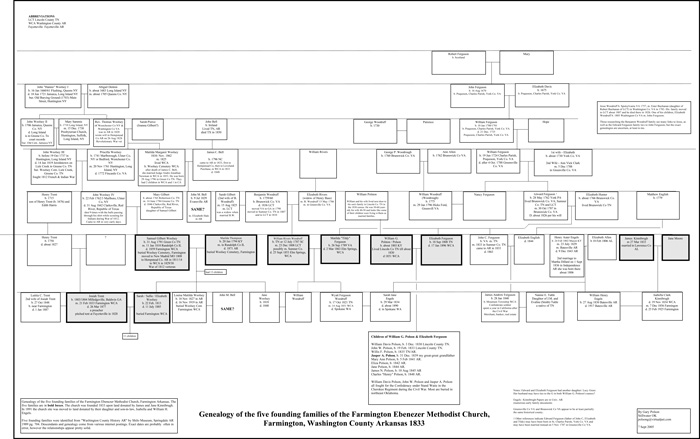
Genealogy of the Five Founding Families of the Farmington Ebenezer Methodist Church, Farmington, Washington County Arkansas 1833
I had hoped the chart above might lead me to the ancestors of William G. Polson, but it did not. The church had split log pews, one hymnbook, and a circuit riding preacher that came by once a month for services.
Many of William G. Polson’s descendants, including W.D. Polson, Flora Polson, and dozens more are buried in Polson Cemetery near Southwest City Missouri. I have visited the cemetery several times and became friends with the caretaker, a fellow Polson family historian and distant relative that one time looked amazingly like my father’s sister. On my first visit to the cemetery on 7 July 1980, I was accompanied by my parents and by my grandmother Polson.
That same day we visited another rural cemetery and my grandmother learned my grandfather Polson had a brother she had never known existed. Later, an elderly relative hesitatingly revealed the story behind the brother, and his death. This was but one of many stories I learned of my family during my research.
I visited the grave of William G. Polson’s wife, Elizabeth, and several other descendants in Prairie Grove, Arkansas several times, but was never able to identify where he was buried. The cemetery is very close to Prairie Grove Battlefield State Park where my Polson ancestors fought in a well known Civil War battle.
Focusing in on William G. Polson
Elizabeth Polson’s stone was broken in half when I first visited there (1988 or 1989). For a long time I thought of trying to replace her stone. Many years later I met a young man named Polson at a seminar. When we visited during a break, I learned his family had since repaired her stone. I was overcome with gratitude.
We spent countless hours trying to find where William G. Polson was buried (died in Arkansas in 1851), including my wife and I tromping thru lots of brush in northwest Arkansas. All we have left is a few guesses tied to field stones in some small family cemeteries, one of which is the Woolsey Wet Prairie Sanctuary created by the City of Fayetteville Arkansas. The wetlands were created to compensate for wetlands used by the city’s new wastewater treatment center. We stomped all over heck and back looking for it. After we returned home, I emailed the city asking them where it was. A gentleman with the city emailed me an aerial photo of it from Google Earth and politely told me the site is no longer public lands. You must make arrangements with the city to visit the small cemetery once on the farm of Samuel Gilbert Woolsey (friend of my William G. Polson). I have yet to visit the cemetery in person. My understanding is their is one large stone, a few other grave stones, then many field stones. The city said the cemetery had been vandalized at one time (good grief, they even vandalize cemeteries I can’t find).
I learned the 1830 Lincoln County Tennessee tax roll was taken by men called Captains. Tennessee counties were divided into Captain’s Districts from 1796-1836. They were called Captain’s Districts because militia captains presided over companies within their geographical borders. One such company was Captain William Polston’s Company. His company included Willis A. Poulston, John D. Poulston, William Poulston, Josiah Norwood, and several other last names familiar to me. Caddycornered to Captain Polston’s Company was Captain James Rorex’s Company.
At the Washington County AR courthouse, I learned William G. Polson’s wife, Elizabeth, registered a pattern of marking the ears of livestock as a brand with Washington County AR after his passing.
As time went on, I learned a Samuel Rorex, born 1809 in Tennessee married a Sarah Polston, and many of these Rorex’s were in Jackson County, Alabama.
An Eliza Polson also turned up in Alabama at times in that era.
Trying traditional and non-traditional approaches
I identified several Washington County Arkansas families (including some previously from Lincoln County Tennessee) that tended to intermarry with descendants of one another, including descendant of my William G. Polson. I charted the genealogies of these inter-related families in The Moores, Lampkins, Stevenson, Norwood, Polson / Polston, Cabe, Givens, and Hardy Family Genealogy Chart.

Genealogy of the interrelated Moores, Lampkins, Stevenson, Norwood, Polson / Polston, Cabe, Givens, and Hardy Families
I had hoped constructing this chart would lead me to some new knowledge of the ancestors of William G. Polston, but it did not.
Through time I corresponded with approximately 25 researchers working on my and other Polson families. The bulk of that was done back in the days of pen and ink. Many of those individuals are now deceased.
I visited many genealogy libraries including those in Stillwater OK Public Library, Fayetteville AR public Library, the Tulsa Public Library, Tulsa Genealogical Society Library, State of Oklahoma Historical Society, LDS Family History Library in Salt Lake City UT, and others. I attended several genealogy conferences and watched RootsTech talks hoping for a lead.
I learned how to research the various Cherokee rolls and learned more about several of my family members. I tried to access the Dawes rolls applications as they contain much more information than the rolls, but I was never able to easily get to them.
I found a book titled, Cherokee Cavaliers. The book is a collection of about 200 letters between the Ridge-Watie-Boudinot families. Some of the letters mention William Davis Polson (son of my William G. Polson). I learned the letters were transcribed by the WPA from a trunk of about 2,000 letters discovered in a farm house in 1919. I was later able to view copies of many of those letters in the Western History Collection of the University of Oklahoma Library. Among many other things, I came away with a sense of how rare paper was out here in the early days. They were writing on both sides of every scrap of paper they could find. The collection includes reports on the sawmill at Honey Creek, Indian Territory (where Grand Lake now is) ran by William Davis (WD) Polson for Stand Watie.
I and later, my wife and I, have visited countless cemeteries. Coming from rural Oklahoma I am used to wandering neglected and overgrown cemeteries. However, we once encountered one in Washington County AR I was flat out unable to physically enter. Tall trees accompanied by hundreds of shorter trees shooting up with large vines heavily intertwined among them plus several of the larger trees had broken off in an ice storm and dropped large limbs down on top of this mess. It was physically impossible to enter. You could see a few graves through the greenery, but you could not enter the cemetery.
William Davis Polson’s second wife, Sarah Francis Pollard, is buried in there somewhere, but it is totally impassible. Walker-Sutton Cemetery is in the town of Fayetteville AR, just across the street from the Confederate Cemetery. Part of this cemetery is kept, the rest is open farmland or jungle. A close look at the image will also reveal there is a barbed wire fence around it, not that it is really needed. I tried to encourage a local Church scout troop to clean it up. The Washington County Arkansas Cemetery Preservation group says that part of the cemetery is on private land and nothing can be done.
Hitting the end of my rope
I reached a time where I found almost nothing new about William G. Polson for many, many years. During those years I continued to assemble records of several other large Polson families hoping they would somehow cross into my line but they never did.
About 2003 I gave up and broke the rules. I picked a William Polston that looked like he could be the father of my William G. Polson and started researching him. The one I picked was William Polton / Poulton / Poulson / Polson born Virginia about 1775, married Lucy Davis. He was said to be the son of Issac Poulton and Ann Green of Virginia. I even created an Isaac Poulton web page hoping to find someone who could document my connection to this family. All I received were a few notes from people wanting to learn more about the Green family (Isaac’s wife).
All the while I continued honing my genealogy skills and knowledge of the resources available by continuing to work on other my other family lines. That was easy to do as I have since learned I have to go back something over 6 generations to find the first person in my family tree that immigrated to the United States. The earliest one I have positively identified is in my 9th generation.
Several years back, I made an online genealogy friend. His wife is a descendant of William G. Polson. He travels and photographs graves, cemeteries, Civil War events, Cherokee historical sites and other places often relevant to the family of William G. Polson. Those photos often encouraged me and helped provide the necessary motivation to keep pushing on.
Within the last couple years I made another online friend. This man is a Methodist minister. He is the grandson of a descendant of William G. Polson I visited with a few times back when I first started this quest. The grandson is the zillionth Polson descendant of William G. Polson that became a Methodist preacher. I have always associated the large number of Polson’s becoming Methodist ministers with the Methodist missionaries working among the Cherokees in Northwest Arkansas. MANY times, I have met or spoken with a Polson that told me they or their father was a minister. I tell them he is a Methodist preacher and they ask me how I knew.
I found an Elizabeth Polson (same name as my William G. Polson’s wife) in various documents in Jackson County, Alabama. I also found a Lucy / Lucia Polson in the same county in 1850 and 1860.
With the advancing age of my parents, I became the caretaker of several thousand historical family photos of several family lines. Most of them from the earlier days of photography are not labeled. I purchased a nice flatbed scanner and undertook an effort to scan them. I made it though photo #276 and burned out. I keep telling myself I need to start scanning again, but I keep finding excuses not to.
About 2014 I purchased one year of access to Fold3 and gained access to the Cherokee Dawes roll applications. However, I became busy in other responsibilities and made little use of them. About 2015 Ancestry.com made the Dawes roll applications available and I feasted upon them. The Cherokees traveled to central points to be interviewed and listed on the rolls being created by the U.S. government. They were asked a lengthy set of questions about their heritage, parents, spouses, children, and places of residence. Among my favorite responses was that of my great-grandfather William Alexander Polson. When asked if his three children were still living, he answered, “Yessir, they were this morning.” William Alexander Polson’s wife and children (including my 2 week old grandfather) were allotted land near my hometown. It brought them to within a few miles of where I was later born.
About 2015 FamilySearch made it possible to directly link visual images of census records and other documents to your ancestors. I hit that with abandon, tying many hundreds of records to my ancestors. I hoped all these records might lead me to William G. Polson’s parents, but instead they helped me further many of my other family lines.
I was still left with the same questions I had for so long.
The questions
By August 2016, after all these years I still had lots questions about William G. Polson and no answers.
- Who were William G. Polson’s parents
- Where was William G. Polson born?
- Where is William G. Polson buried?
- Is Marry Henrietta Polson married to Josiah Norwood a sister of my William G. Polson?
- Are William Polson / Poulton and Lucy Davis the parents of my William G. Polson?
- Am I kin to the Rorex family and the Proctor family associated with William Polson and Lucy Davis?
- Were the Willis A. Poulston, John D. Poulston, and William Poulston on the 1930 Lincoln County Tennessee tax rolls my people? Were some of them brothers of or the father of my William G. Polson? Was one of them my William G. Polston?
- Did the “Greer”in William G. Polson’s name come from Joseph Greer, known as the Kings Mountain Messenger, that ran a mill near the Polson’s in Lincoln County Tennessee?
- Where did the “Davis” in William Davis Polson’s name come from?
- Why did so many families move from Lincoln County Tennessee (LCT) to within proximity of one another in Washington County Arkansas? They even named many of the landmarks and towns for similar sites back in LCT?
- Do I really have the right Elizabeth listed as the wife of my William G. Polson (I have Elizabeth Ferguson listed as his spouse)?
- Descendants of my William G. Polson intermarried with the Cherokees. William G. Polson’s family showed up in northwest Arkansas in the era Cherokees known as the Early Settlers settled there prior to the forceful removal of thousands of Cherokees from the East (from areas not from from Lincoln County Tennessee). Is my William G. Polson a descendant of Cherokees as well?
- Why did three of William G. Polson’s son’s fight alongside the Cherokees in the Confederacy? Were their Polson family part Cherokee?
- Are the early Polson’s in Jackson County Alabama kin to my William G. Polson, and thus kin to me?
- Why didn’t some of my Polson’s participate in the Oklahoma Land Runs? Their families had been in the region for decades prior to the run. Especially why didn’t some of the younger single males or those with young families participate?
But things were about to change…
Links to the other two posts
- Part 2 Finding the missing genealogy document to extend a Polson family line
- Part 3 Epilogue: After finding the missing genealogy document to extend a Polson family line
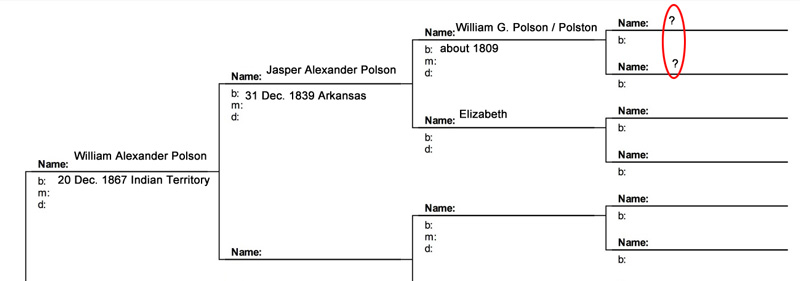

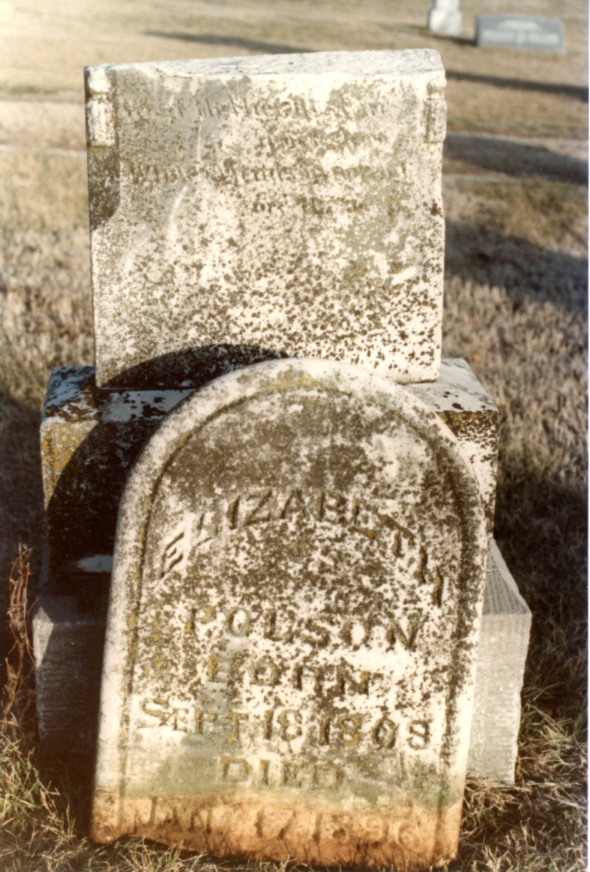
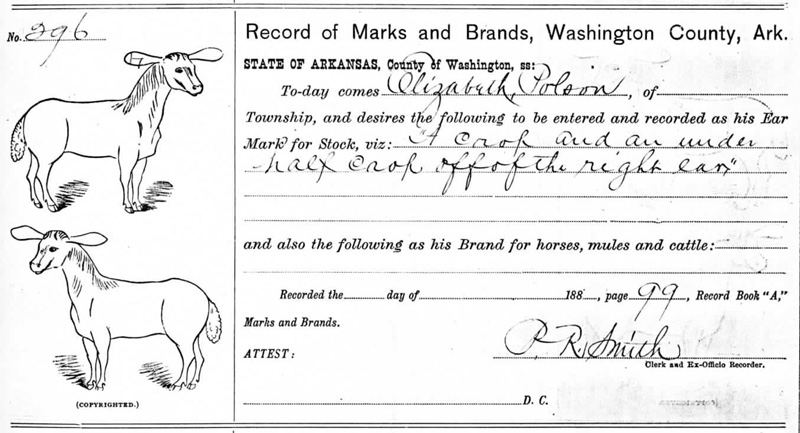
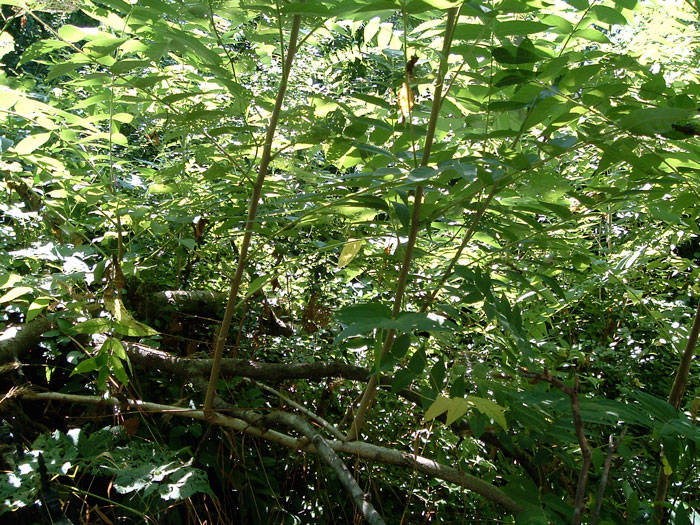
My paternal great grandmother was Anna Sutton VanLandingham who was born in Mutual,Oklahoma sometime in the early 1890s.Her mother’s maiden name was Polson or,possibly,Poulson.My paternal great grandfather William Jesse Edward VanLandingham was born in the 1880s and died around Parma,Idaho in 1947.They came to Idaho around 1914 or 1915.My grandfather was William Lynn VanLandingham(1910-1992),he had a sister Lois and a brother Clarence Ivan VanLandingham.
Thanks for your note, but we are not trying to create a Polson genealogy page here as much as we are trying to talk about an example of the journey of being stuck at a certain place in your genealogy for decades and finally breaking through.
As to the specific Polson/Pouson you mentioned without further information, I do not recognize them or the last name you mention multiple times.
Good luck with the journey of finding those in your family tree.
gary
Hi there,
I have been studying this for a while and I do know Etta Polson married John “Ott” Jordan and was the daughter of Jasper Polson. I do know Etta was born and lived on a Cherokee reservation for a while. I know this because she was my Great-Grandmother and my Grandma has been helping me build a family tree. I’ve also been using Ancestry and working with other family members. I hope this helps!
Amanda
Thanks for your note. I am familiar with your Jasper Polson. He is my great-great grandfather and buried in Dawes Cemetery in Chelsa Oklahoma. We first visited his grave, along with his wife’s grave, about 1981 with my parents and my father’s mother. My father’s mother was not aware of his name or where he had been buried. Several of Jasper’s brothers and their families are buried in Polson Cemetery near Southwest City Missouri. A few more plus Jasper’s mother are buried in Prairie Grove Cemetery near the battlefield in NW Arkansas. Jasper and one of his brothers fought with the Cherokee Mounted Volunteers in the Civil War.
Your Henrietta “Etta” carries the first name of one of the sisters of Jasper Polson’s father. Henrietta (Polson) Norwood wife of Josiah Norwood.
“On a Cherokee Reservation” means something different through time. “Reservation” now has certain legal meanings concerning the 5 Civilized Tribes in Oklahoma. Per my view, the boundaries of the land assigned to the Cherokee Tribe in the mid 1800’s were “assigned lands” not a reservation. I grew up in that area and never heard it referred to as a reservation. Now the State / Federal Government treat those lands as a reservation in certain circumstances. The deed to my parents house begins with references to several Native American treaties back to 1828 but does not refer to it being on a reservation.
Sorry about our slow response. Good luck with your research. Grandmothers are a great place to start.
Your Polsons might go back to a man named Asel with ambiguous ancestry? My Polsons go back to a man in MD that is white, free person of color and Native Indian on different censuses. I can’t find his parents and have no idea how he came to be. It’s been a struggle.
I am adding some more info on your Asel from my research of his family many years ago. I am aware of his Benton Co Missouri descents and another batch married into the Sunday family of Oolagah Oklahoma. In 1981 I met with an elderly descendant of Asel along with his wife in Coffeyville Kansas. He was a son of William Martin son of Martin son of Asel son of your Asel.
I am absolutely not saying what follows is true and accurate, but two other elderly researchers sent me documents back in the early 1980s claiming your Asel was son of Isaac Poulson / Polson of Marshall County Virginia. One of those researchers was a Poleson, a line descending from your Asel through William Martin Poleson b. 1851 WV.
FamilySearch.org lists your Asel as #93G7-YJV. Always do your own research do not directly accept genealogies you find online. FamilySearch does supply several actual documents making a compelling case at least for some of the info surrounding your Asel and his descendants.
Thanks again for your note.